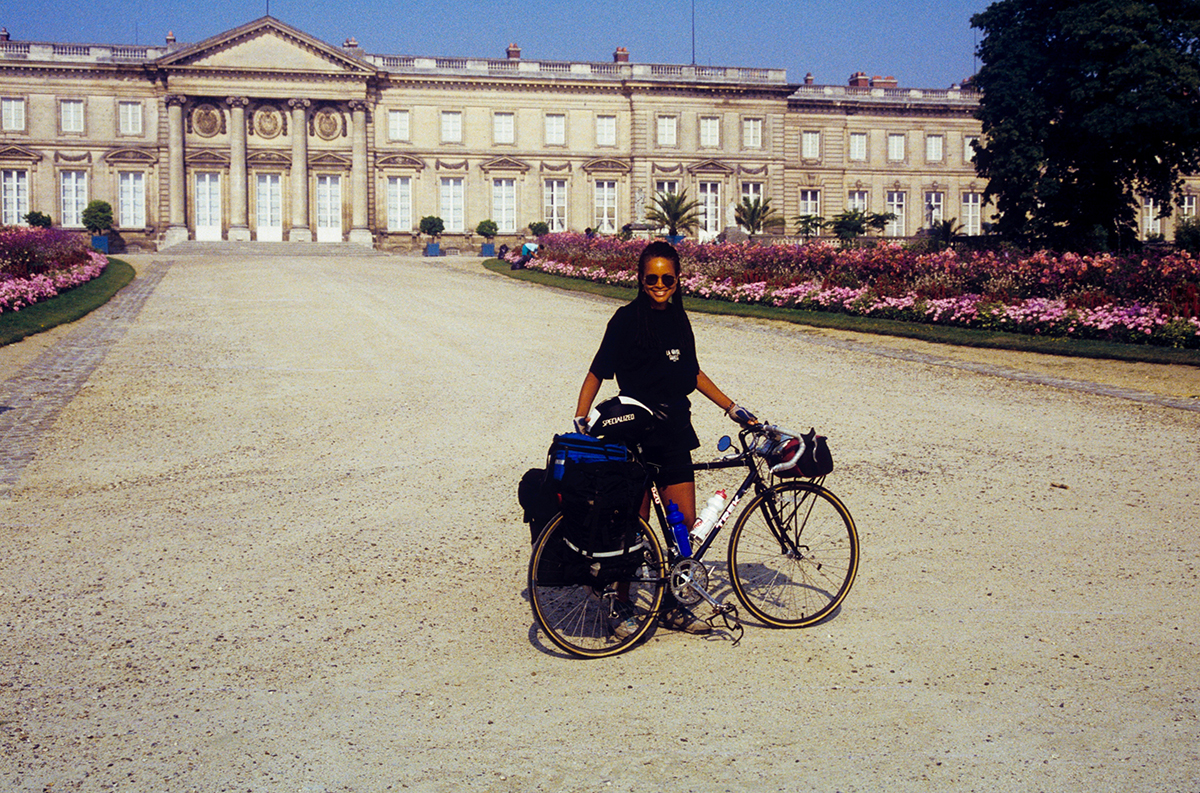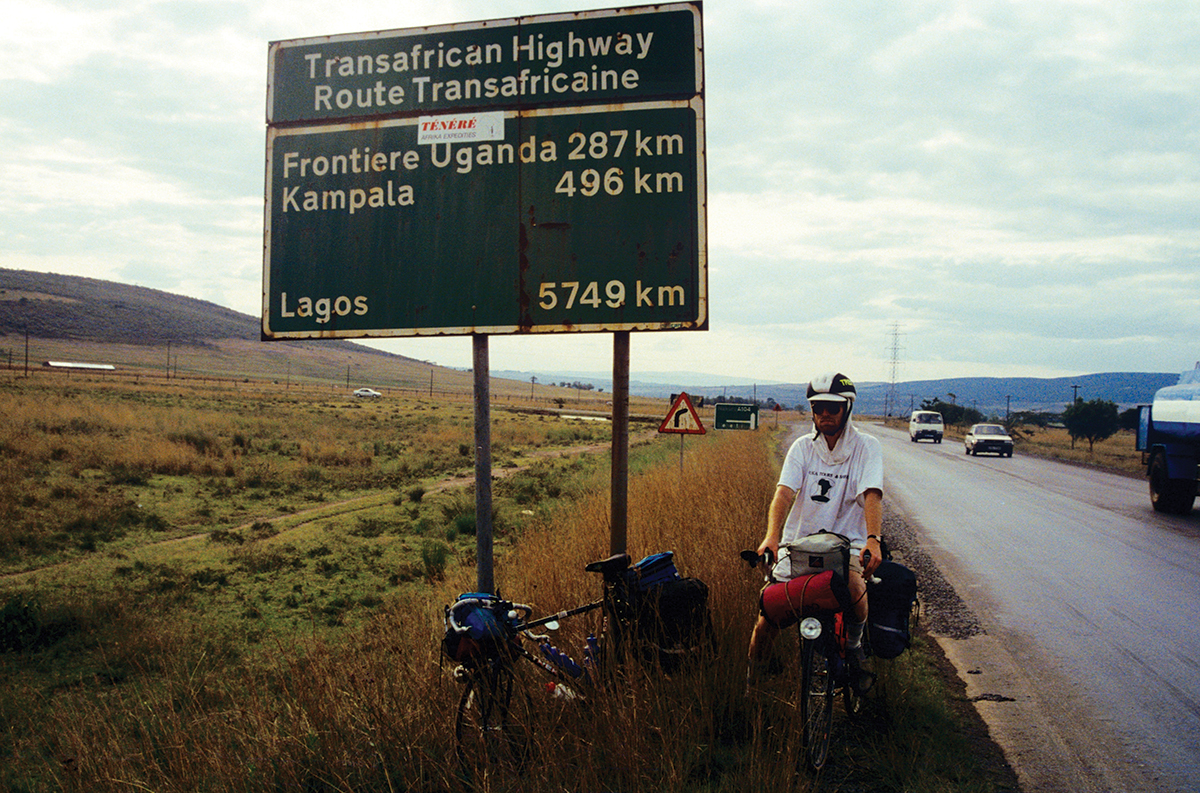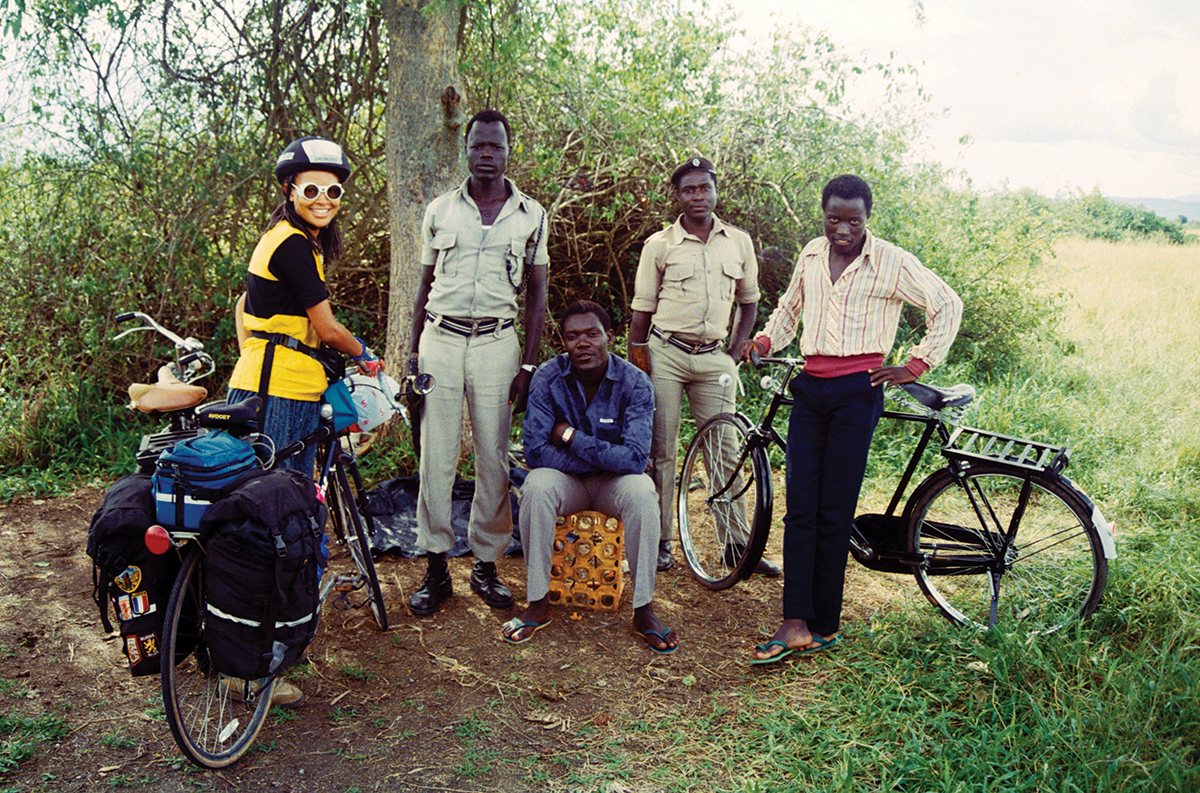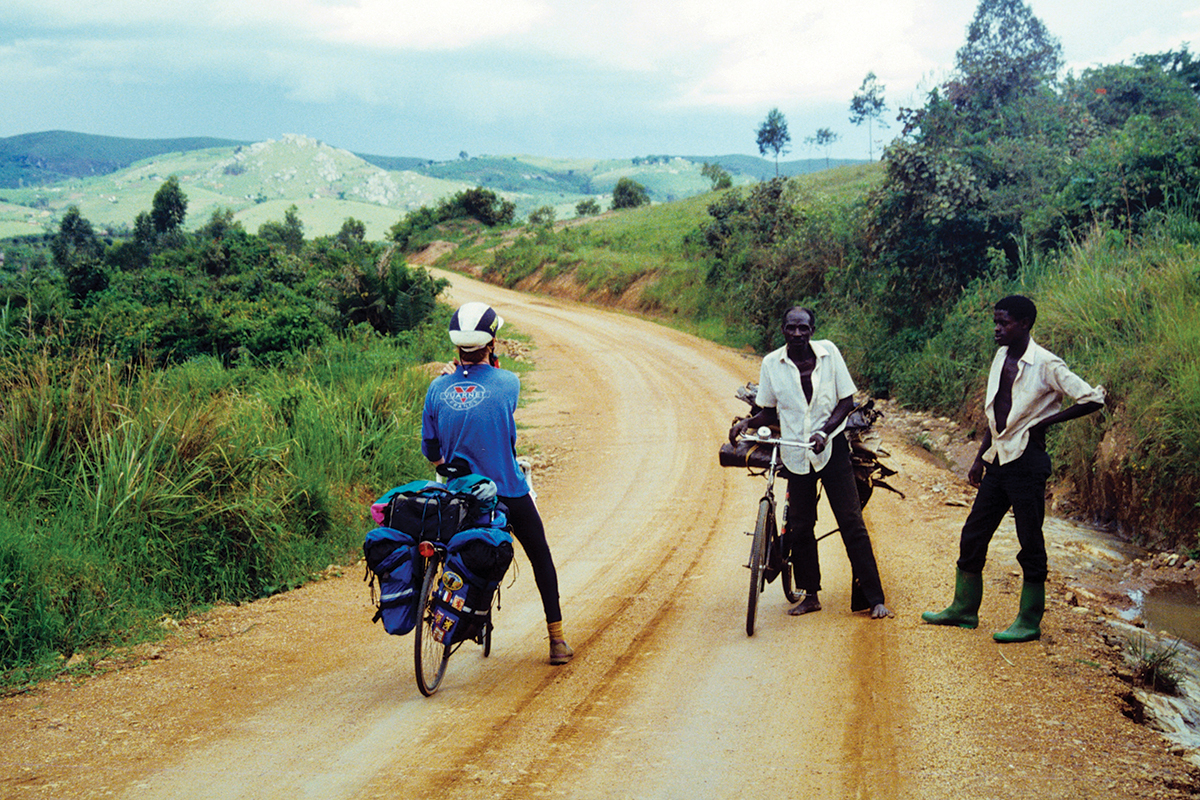Bicycle Odyssey
This article first appeared in the Oct./Nov. 2021 issue of Adventure Cyclist magazine.
In the moonless night, I zipped open our tent a few inches to investigate the sounds of munching and soft footfalls that surrounded us. We were the only ones in a tent on a wide expanse of green lawn at Fisherman’s Camp near Lake Naivasha, Kenya. My heart froze when I saw that the sounds came from several large hippopotami grazing around our flimsy shelter. Two of them turned to look in my direction, and their eyes glinted back at me, red in my flashlight. I quickly moved the beam, not wanting to irritate them. God knows what they would do if they felt threatened. I could make out the huge, black hulks of their bodies as they slowly moved around us. Apparently, hippos come out of the lake at night to graze. Now we understood why the campground was so well manicured and deserted, apart from us.
But I urgently had to go to the bathroom, and the night was still young. Near the equator, the sun rises at about 6:00 AM and sets at 6:00 PM, which gives an even 12 hours of daylight and 12 hours of darkness. We had a long way to go before dawn. I roused my husband, Dermot, to come with me and hold the flashlight so I would be safe — at least we would be together if the hippos attacked. Mission accomplished, we zipped up tight in our tent and nervously settled into our sleeping bags with only a millimeter of canvas sheeting separating us from curious hippopotami.
We slept fitfully that night and woke at dawn to find the lawn empty. The hippos had made their way back to the lake to submerge their massive bodies. Only their ears and noses peeked above the surface.
In the summer of 1991, Dermot and I quit our teaching jobs, packed up everything in our house, and rented our home to three students for a year so we could take an around-the-world bicycle trip. When I tell people Dermot and I are no longer married, they usually nod and say, “Yes, travel is hard on a relationship.” But they don’t understand that we traveled well together. We spent five years planning, poring over maps and guidebooks, reading all the travel adventure books we could get our hands on, and saving money. We structured a skeleton itinerary by figuring out the best time of year to travel through each area of the world on our list.

Dermot’s parents were from England and Scotland. We wanted to visit his ancestral homeland and see his relatives on our trip. Because of the Middle Passage and slavery, my African heritage was untraceable to a specific country (that has changed recently with DNA testing). I had longed to visit sub-Saharan Africa, and Kenya was the country we could work into our itinerary.
We bought round-the-world tickets: Los Angeles to London, London to Nairobi via Moscow, Nairobi to Bombay (now called Mumbai), Bombay to Goa, Trivandrum (now Thiruvananthapuram) to Madras (now Chennai), Madras to Calcutta (now Kolkata), Calcutta to Kathmandu, Kathmandu to Bangkok, Bangkok to Singapore, Singapore to Denpasar, Denpasar to Biak, Biak to Honolulu, and Honolulu to Los Angeles. That was the skeleton of our trip. The highlights and magical gems lay hidden in between those cities. Travel by bicycle gives a personal view of the villages and hamlets that might not even be on a map. You meet people at tea stands by the side of the road in little places where no one else stops except for locals and other bicyclists.
We had no personal cell phones in 1991, no cyber cafés or portable computers to send a quick email home, no ATMs we could use outside the U.S. Plus, most places we traveled to didn’t take credit cards. We plotted out our trip so we could check into an American Express office once a month. Our family knew our itinerary, and they wrote to us in care of different American Express offices. In the major cities where we touched base, we picked up our mail from home and purchased American Express Travelers Cheques, which we cashed at local banks as we traveled. Our parents and families waited for long stretches without news, and I’m sure they worried terribly about us. We tried to call home about once a month to connect with them.
As our plane took off, my anxieties melted away. The previous month had been a nightmare of organization and endless lists. I was exhausted from lack of sleep and worry. My stress dissipated as we cut ties with the earth. We carried with us everything we needed, and nothing more could be done to prepare. I sighed, relaxed, and settled into my seat.
July in Scotland was chillier than expected, so we piled on all the warm clothes we had brought with us. Because of the rain, we layered jackets and pants made out of GoreTex for warmth. The big highlights of each day’s cycling were tea breaks with scones or biscuits to warm and fuel our bodies.
The terrain was deceptive. Our bodies had the endurance to ride many miles in a day, but 40 miles in Scotland often included numerous hills and strong headwinds. When we stopped to rest, the midges — tiny bugs that swarmed and delivered a nasty bite — attacked any exposed skin, leaving big itchy welts much larger than the mouths that gave them.
We had trained as much as we could before the trip on the trails in the mountains above our house in Altadena, California, even going up to the peak of Mount Wilson and back — a climb of 4,000 feet on dirt switchbacks. But nothing can completely prepare you for the journey of bicycling every day for miles. We developed new muscles and built stamina on this first leg of our travels across the Scottish Highlands. When we asked a Scot about the terrain up ahead, he answered with “fairly flat.” We learned that this response translated to “hilly” in our language.

We landed at Jomo Kenyatta International Airport in Nairobi in the morning and rolled our bikes out to pump up the tires. We fortified ourselves with a sweet roll and tea with milk at the airport, clipped on our panniers, and rode 10 miles into the city. Traffic was light on the two-lane road in the early morning hours. We cycled past zebras and giraffes grazing in the plains. The view of those wild animals in their natural habitat felt like the authentic beginning of our adventure.
We had both lived in Europe before and had friends and family there. The continent was cozy and familiar. The European portion of our trip was a visit to reconnect with people and share familiar lands with each other. Dermot showed me his English and Scottish heritage and what he had experienced on previous trips in England, Scotland, and Holland. I connected him with my years of living in France and Spain and my extended family in Denmark. But from now on, we would face the new and unknown together at the same time.
Before we left on our voyage, I had purchased a bike dress designed by an enterprising American woman bicyclist. I thought the dress would be a good idea for a modest cover-up and would make me more presentable on the road and in villages. But it proved to be too short for the more conservative Kenyans, and my bike pants were too formfitting. After I overheard disapproving remarks, I covered up with a wraparound kanga (sarong) when we stopped for meals or shopped in the marketplace. In Kampala, I purchased a custom-made outfit of loose-fitting long pants and a tunic top made from a stunning African print. The light cotton breathed well. The breeze blew through the fabric and cooled me as we cycled. I also blended in much better with the modest East African attire.
Every day, we slathered sun protection on our faces. Every night, we coated ourselves with insect repellant chock-full of DEET because the best malaria prevention is to not get bitten by a mosquito. In the mornings, we each filled two bottles with water from the tap and added a water-purifying tablet. By midmorning, we were drinking warm, chlorine-laden water. It tasted like we were drinking from a swimming pool. It wasn’t great, but it was strangely comforting because we knew we wouldn’t become sick from the water.
We had applied for Ugandan visas on the suggestion of a fellow traveler we met in Nairobi. In our initial planning, we had given ourselves two months to travel within Africa. There were lots of possibilities. We could go down all the way to South Africa, but we were unwilling to visit the country until they abolished apartheid. Other travelers told us South African hospitality was wonderful, especially in the countryside. I wasn’t sure what kind of reception a mixed-race couple would have there. American Blacks were granted honorary “White” status in South Africa in those days, but off the beaten track where bicyclists like to roam, that could be a different story. Uganda beckoned. We would follow the Trans-African Highway west and see what happened.
While bicycling through Uganda, we came across numerous reminders of the recent wars. Idi Amin’s reign of terror was fresh in our memories. He was president of Uganda from 1971 to 1979; many called him the “Butcher of Uganda” and considered him one of the most brutal leaders in world history. Between 300,000 and 500,000 people were killed during his rule. He gave the South Asian population of 80,000 a short time to leave the country or be put into concentration camps, and he seized their assets. In 1990 the new president, Museveni, invited Asians who had been forced to leave during Idi Amin’s reign to return to the country. The government even returned a portion of their assets. Throughout our trip, we saw businesses owned by Asians that had reopened. A positive and hopeful spirit abounded. We learned much history as we bicycled through this stunning, verdant country.
Few tourists had visited Uganda since the early 1970s because of the political turmoil. Tourism was starting up again slowly, so we saw very few other travelers on our trip. This made for many pleasant encounters with Ugandans, who were welcoming and eager to talk to us.
At the time we entered the country, a large project was in progress to rebuild the roads. For much of our ride, we cycled on freshly paved roads built by either Chinese or Yugoslavian aid workers. We also rode on long stretches of hard-packed dirt roads. The earth was a rich red, a gorgeous contrast to the sharp blue of the sky.

The bike ride from Fort Portal to Kasese showed us the most magnificent scenery at that point of our trip — verdant and undulating. That luscious vegetation required water, though. A downpour forced us to pull over and wait about 10 miles from town. It rained for 15 to 20 minutes, once or twice a day, during the short rainy season. The cloudbursts came on without notice, and the sheets of driving rain cut off visibility. We couldn’t walk or ride a bicycle, so we sought shelter.
A lovely camaraderie existed in Uganda when it rained. An unwritten rule extended hospitality to all who passed by when the showers hit. When the sky opened up, people welcomed us onto porches, under awnings, in front of houses, or in the doorways of establishments. We stood and waited quietly under the shelter for 20 minutes to half an hour. A few times about 10 of us huddled together on a stranger’s porch. Even trucks and cars (not many drove on the roads) stopped for those short, fierce downpours. We stared out into the gray sheets of rain and watched the water run down the side of the road in muddy rivulets. We shared a brief bond in those moments, a fellowship of humans thrown into a difficult situation together. We drifted into a reverie, a quiet meditation amplified by the sound of the rainfall. When the showers eased up, we all moved on with a polite “thank you” and “goodbye.”
Uganda possesses spectacular natural beauty. Fertile, red earth abounds. Every day we delighted in the lush, green hills we rode through. The daily rainfall was a small price to pay to bicycle through such gorgeous nature.
We left Kasese late, around noon, thinking we would pedal only the 25 miles to Queen Elizabeth National Park that day. We were in Uganda’s Rift Valley, and we passed herds of antelope grazing in the lush fields. But at the turnoff for the park, we saw that we had another 15 miles ahead of us on a rough dirt road. We waffled for several minutes and then decided to skip the park and the 30-mile detour it would cause and push on to Kabale. This area was near Zaire (what is now the Democratic Republic of the Congo). We stopped for lunch at a small roadside café where truck drivers gathered. We struck up a conversation with John, one of the drivers, while we ate together.
John sipped a cup of hot milk tea. “We are waiting here to cross the border to Zaire, but we need to get a large convoy together for safety,” he said.
“Why is that, John?” Dermot asked.
“Across the border, bandits often force trucks off the road and rob them of their goods.”
My eyes grew wide. “Oh, my!”
“The road conditions are very bad — muddy roads full of potholes.”
“We thought about going to Zaire, but we didn’t get visas,” Dermot said.
John shook his head. “You would be wise not to go. It wouldn’t be safe for you on your bicycles.”

We pushed on past Lake George and Lake Edward, climbing slowly out of the Rift Valley. It grew late with no hotels in sight. We asked people on the road where we could find a place to stay, and they directed us to Father Michael’s parish in the next town. We climbed on through the vibrant hills for about two more miles and approached a church and a house overlooking the hills and the Rift Valley. In the valley, we saw deep craters filled with lush banana trees and blue lakes. White clouds dotted the azure sky. The sight was refreshing, gorgeous, and pure — a hidden Shangri-la.
We knocked on the door of the parish and met Father Michael, an affable and gracious man in his 30s. He greeted us with a smile.
“How may I help you?” he asked.
“Hello. My name is Dermot. This is my wife, Carla.”
“Hello.”
“We are sorry to bother you,” I said. “But we are bicycling, and we won’t be able to make it to the next town before dark. Would it be possible to camp at your parish?”
“We have a tent,” Dermot added.
“Of course! But please, I invite you to stay in my guest cottage.” Father Michael pointed to a nearby structure.
He walked us over to the cottage and opened the door. “Make yourself at home,” he said.
Dermot and I chatted for a while as we watched the sun set over the view of the hills and the Rift Valley before we washed up and changed.
Father Michael knocked on our door. “Aren’t you coming for dinner?” he asked.
We happily accepted and walked over for a meal of chicken with matoke served in a banana-leaf bowl with a delicious groundnut (peanut) sauce on the side. Father Michael’s generosity and hospitality touched us and helped us in a time of need.
Throughout our trip, we savored chance encounters with exceptional people who opened our eyes to new possibilities and shared their human kindness. We cherished those warm connections we made along the way.
This trip tested our determination, patience, faith, and fortitude. We learned many lessons along the way about ourselves and the world, such as to trust in serendipity; to be open to the unexpected; to welcome detours to magical, hidden places; to be adaptable. Like the massive hippos that grazed around our tent in Kenya, we faced frightening and potentially life-threatening dangers throughout the year. Yet we came through all of those events feeling even more alive, stronger, and grateful to be on our bicycle odyssey.


